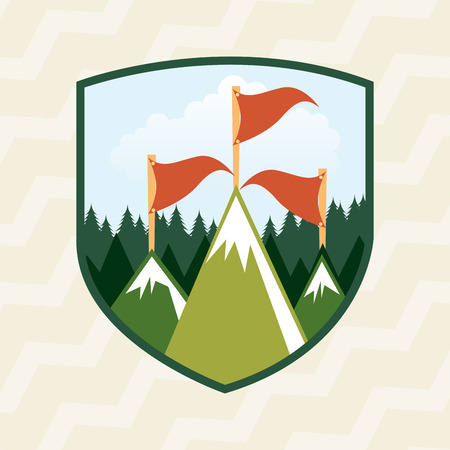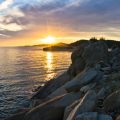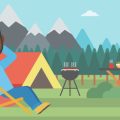1. Introduction to Camping in the Pacific Northwest
The Pacific Northwest, often referred to as the PNW, is a dream destination for outdoor lovers and camping enthusiasts alike. Covering parts of Washington, Oregon, Northern California, and even stretching into British Columbia, this region offers some of the most stunning natural landscapes in the United States.
What makes camping in the PNW so special? Its the perfect mix of emerald forests, crystal-clear lakes, snow-capped mountains, and mild summer weather that creates an ideal environment for outdoor adventures. Whether youre into hiking through moss-draped trails, kayaking on tranquil alpine lakes, or just sitting by a campfire surrounded by towering trees, theres something here for every kind of camper.
Why Campers Love the Pacific Northwest
| Feature | Why It’s Great for Camping |
|---|---|
| Lush Forests | Dense evergreens provide shade, privacy, and a peaceful vibe. |
| Scenic Lakes | Perfect for swimming, fishing, canoeing, or just relaxing by the shore. |
| Mild Summers | Comfortable temperatures make outdoor activities more enjoyable. |
| Diverse Wildlife | Opportunities to spot deer, eagles, otters, and more in their natural habitat. |
| Variety of Campsites | From remote backcountry spots to family-friendly campgrounds with amenities. |
No matter if you’re a seasoned camper or planning your first overnight under the stars, the Pacific Northwest offers endless opportunities to explore nature at its finest. This guide will walk you through ten must-visit forest and lake campgrounds that showcase the best of what this incredible region has to offer.
2. Best Time to Camp in Forests and Lakes of the PNW
The Pacific Northwest (PNW) is known for its lush forests, crystal-clear lakes, and ever-changing weather. Knowing when to plan your camping trip can make all the difference between a damp weekend and an unforgettable adventure. Heres what you need to know about the best times to visit forest and lake campgrounds in Washington, Oregon, and Northern California.
🌤️ Ideal Camping Seasons
While the PNW is beautiful year-round, not every season is ideal for camping—especially near lakes and deep forest areas where rain and cold can hit hard. Heres a quick breakdown of each season:
| Season | Best For | Weather Overview |
|---|---|---|
| Spring (April – June) | Waterfalls, wildflowers, fewer crowds | Cool temps, occasional rain showers |
| Summer (July – September) | Swimming, hiking, warm weather camping | Dry, sunny days with mild nights |
| Fall (October – early November) | Fall foliage, quiet trails | Crisp air, chilly nights, some rainfall |
| Winter (Late November – March) | Snowshoeing, cozy cabin stays | Cold temps, snow in higher elevations |
📅 Best Months to Visit Top Campgrounds
If youre planning to explore top-rated sites like Lake Crescent in Washington or Waldo Lake in Oregon, aim for the late spring through early fall months. July through September typically offer the most reliable weather across most PNW campgrounds.
Top Picks by Month:
- May: Great for early-season hikes and fewer crowds at forest sites.
- July – August: Peak season for swimming and boating in lakes like Timothy Lake and Diablo Lake.
- September: Warm days with cooler nights—perfect for campfires and stargazing.
☁️ Weather Tips You Should Know
- Packed Rain Gear: Even in summer, be prepared for sudden drizzles—especially near coastal forests.
- Bugs: Mosquitoes are common near lakes from late spring through mid-summer. Bring repellent!
- Fire Restrictions: Check local fire bans during dry months before lighting that campfire.
🎒 What to Pack for a Forest or Lake Getaway
| Essentials | Description |
|---|---|
| Tent with Rainfly | A waterproof tent is a must in case of unexpected rain. |
| Mosquito Repellent & Netting | Lakeside camping often means bugs—be ready. |
| Layers of Clothing | Nights can get cold even during summer; pack hoodies or fleece jackets. |
| Sunscreen & Sunglasses | The sun can be strong near open lakes and alpine zones. |
| Bear-Resistant Food Storage | If youre heading into national parks or remote areas, keep food secured. |
Planning your camping trip around the right time of year ensures youll get the most out of what the Pacific Northwests forests and lakes have to offer—from misty mornings among tall pines to clear afternoons on mountain lakeshores. Whether youre pitching a tent lakeside or parking your RV under towering firs, choosing the best season makes all the difference.

3. What Makes a Great Forest and Lake Campground
When planning your next camping trip in the Pacific Northwest, knowing what makes a campground stand out can help you choose the perfect spot. Whether youre pitching a tent or rolling in with an RV, here are the key features to look for in top-rated forest and lake campgrounds.
Accessibility
The best campgrounds are easy to get to but still feel like a true escape into nature. Look for places with well-maintained roads, clear signage, and nearby towns for supplies—especially if youre traveling with family or towing a trailer.
Amenities
A great campground doesn’t mean roughing it without any comfort. While some folks love primitive camping, many top-tier sites offer:
| Amenity | Why It Matters |
|---|---|
| Clean Restrooms & Showers | Staying fresh keeps the experience enjoyable, especially for families. |
| Potable Water | Essential for drinking, cooking, and cleaning without lugging gallons from home. |
| Fire Rings & Picnic Tables | Makes meals and campfire hangs easier and more fun. |
| RV Hookups | Great for longer stays or campers who like extra comforts. |
Scenic Views
The Pacific Northwest is known for its breathtaking landscapes—think tall evergreens, snow-capped peaks, and crystal-clear lakes. A top-notch campground offers stunning views right from your tent flap or camper window. Lakeside spots at sunrise or sunset? Unbeatable.
Recreational Opportunities
The best forest and lake campgrounds don’t just offer a place to sleep—they’re gateways to outdoor adventure. Here are some popular activities to look for:
Hiking Trails Nearby
Whether it’s a short nature walk or a challenging day hike, access to trails adds to the experience.
Water Activities
Lakes should offer more than just pretty reflections. Top sites often allow kayaking, paddleboarding, fishing, and swimming.
Wildlife Watching
Many PNW campgrounds are located in areas rich with wildlife—from bald eagles to black bears (so pack smart!). Great spots provide safe opportunities for nature watching.
Atmosphere & Space
No one wants to feel crammed in while camping. The best sites offer spacious campsites with enough room between neighbors for privacy and peace. Bonus points if you can hear birds instead of generators.
Your Ideal Campground Checklist
| Feature | Check If Available? |
|---|---|
| Easy Access Road & Parking | ☑ |
| Lakeside Views or Access | ☑ |
| Campsite Privacy/Spacing | ☑ |
| Water Activities Allowed | ☑ |
| Biking/Hiking Trails Onsite or Nearby | ☑ |
| Amenities (Water, Toilets, Tables) | ☑ |
If your chosen campground checks most of these boxes, youre in for a memorable adventure under the stars in one of the most beautiful regions in the U.S.
4. Top Tips for Camping Responsibly
When exploring the breathtaking forests and lakes of the Pacific Northwest, its important to camp in a way that protects these natural wonders for future visitors. Whether youre pitching your tent near Crater Lake or setting up by the shores of Lake Wenatchee, following responsible camping practices is key. Here are some top tips to help you enjoy your adventure while minimizing your impact on nature.
Follow Leave No Trace Principles
The Leave No Trace (LNT) principles are essential guidelines for anyone spending time outdoors. They help preserve the environment and ensure that everyone can enjoy clean and beautiful campgrounds. Here’s a quick overview:
| Principle | What It Means |
|---|---|
| Plan Ahead and Prepare | Know the area, weather, and rules before you go. |
| Travel and Camp on Durable Surfaces | Stick to trails and designated campsites to avoid damaging vegetation. |
| Dispose of Waste Properly | Pack out all trash, leftover food, and litter. |
| Leave What You Find | Avoid taking rocks, plants, or artifacts home with you. |
| Minimize Campfire Impact | Use a camp stove or established fire rings; never leave a fire unattended. |
| Respect Wildlife | Observe animals from a distance and don’t feed them. |
| Be Considerate of Other Visitors | Keep noise down and respect others’ outdoor experience. |
Practice Wildfire Safety
The Pacific Northwest is especially vulnerable to wildfires during dry summer months. Always check local fire restrictions before lighting a campfire. If fires are allowed, keep them small, use existing fire rings, and never leave them unattended. Make sure your fire is completely out—cold to the touch—before leaving your campsite or going to sleep.
Quick Fire Safety Checklist:
- Check current fire restrictions at your campground or park website.
- Only build fires in designated rings or pits.
- Keep water and a shovel nearby at all times.
- Drown, stir, and feel your campfire until it’s cold before leaving.
Respect Wildlife
You’re sharing the forest with animals like deer, raccoons, bears, and birds. Give them space—they’re not used to human food or attention. Store all food securely in bear-proof containers or locked vehicles, especially when camping near places like Mount Rainier or Olympic National Park where wildlife sightings are common.
Wildlife Etiquette:
- Never feed wild animals—it makes them dependent on humans and can be dangerous for both parties.
- Keep pets leashed so they don’t disturb wildlife habitats.
- Use binoculars or zoom lenses to observe from afar—don’t approach animals for photos.
Caring for nature while enjoying it ensures that the Pacific Northwest remains a stunning destination for generations of campers to come. With just a little effort, you can make a big difference!
5. Planning Your Ultimate Pacific Northwest Camping Trip
Getting ready for a camping trip in the Pacific Northwest (PNW) means more than just packing your gear. Whether youre heading to forested escapes like Olympic National Forest or lakeside gems such as Lake Quinault, smart planning can make or break your adventure. Heres how to get started.
Know the Permit Requirements
Many of the top campgrounds in the PNW are located within national parks, state parks, and protected wilderness areas. This means you might need permits not only for camping but also for activities like hiking, fishing, and even parking.
Common Permits You May Need
| Permit Type | Where Its Needed | How to Get It |
|---|---|---|
| National Park Entry Pass | Olympic National Park, Mount Rainier National Park | nps.gov |
| Backcountry/Wilderness Permit | Enchanted Valley, Alpine Lakes Wilderness | recreation.gov |
| Discover Pass (WA) | Washington State Parks like Moran or Deception Pass | discoverpass.wa.gov |
Use Reservation Systems Wisely
Some of the most popular campgrounds—like Crater Lake’s Mazama Village or Oregons Lost Lake—book out months in advance during peak season (June through September). Make sure to use official reservation systems early to secure your spot.
Top Sites for Reservations
- Recreation.gov: Federal lands including national parks and forests.
- ReserveAmerica: Many state parks across Oregon and Washington.
- Oregon State Parks: For locations like Silver Falls or Fort Stevens.
Family-Friendly Planning Tips
If you’re bringing kids along, look for campgrounds with amenities like flush toilets, easy hiking trails, swimming areas, and ranger programs. Here are some top picks for families:
Kid-Friendly Campground Features
| Campground | State | Family Perks |
|---|---|---|
| Larrabee State Park | Washington | Sandy beach access, tide pools, playgrounds nearby |
| Suttle Lake Campground | Oregon | Canoe rentals, gentle trails, shallow swimming areas |
| Klahowya Campground (Olympic NF) | Washington | Paved loops for biking, short nature walks, quiet setting |
Additional Tips for a Smooth Trip
- Check fire restrictions: The PNW can experience dry summers; always check current fire bans before lighting a campfire.
- Pack layers: Weather can shift quickly—even in summer—so bring warm clothing and rain gear.
- Bring bug spray: Mosquitoes love lakes and forests as much as campers do!
- Leave No Trace: Protect these beautiful places by packing out all trash and respecting wildlife.
A little preparation goes a long way in making your Pacific Northwest camping trip unforgettable. From permits to reservations to kid-friendly features, plan ahead so you can relax once youre out under the trees or beside a peaceful lake.


